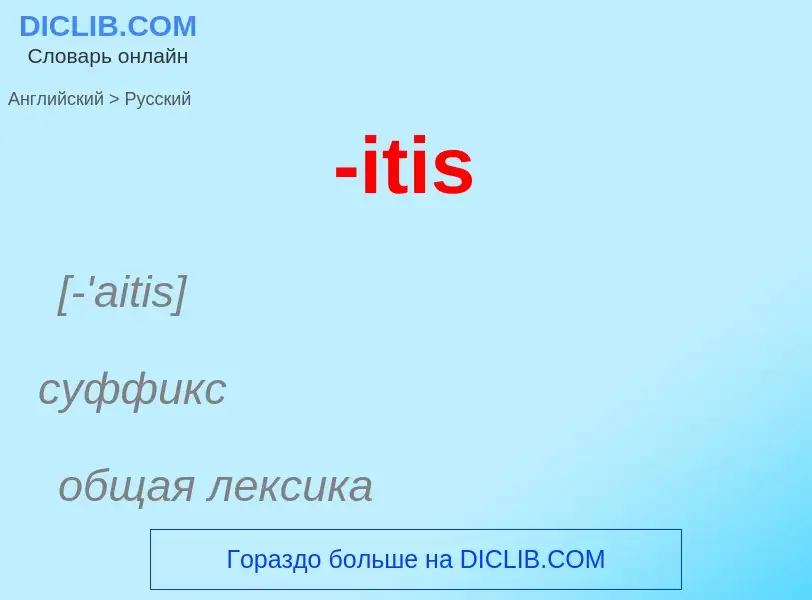Translation and analysis of words by ChatGPT artificial intelligence
On this page you can get a detailed analysis of a word or phrase, produced by the best artificial intelligence technology to date:
- how the word is used
- frequency of use
- it is used more often in oral or written speech
- word translation options
- usage examples (several phrases with translation)
- etymology
-itis - translation to russian
[-'aitis]
суффикс
общая лексика
образует названия болезней (обычно воспалительного характера)
Definition
Wikipedia
Inflammation (from Latin: inflammatio) is part of the complex biological response of body tissues to harmful stimuli, such as pathogens, damaged cells, or irritants, and is a protective response involving immune cells, blood vessels, and molecular mediators. The function of inflammation is to eliminate the initial cause of cell injury, clear out necrotic cells and tissues damaged from the original insult and the inflammatory process, and initiate tissue repair.
The five cardinal signs are heat, pain, redness, swelling, and loss of function (Latin calor, dolor, rubor, tumor, and functio laesa). Inflammation is a generic response, and therefore it is considered as a mechanism of innate immunity, as compared to adaptive immunity, which is specific for each pathogen. Too little inflammation could lead to progressive tissue destruction by the harmful stimulus (e.g. bacteria) and compromise the survival of the organism. In contrast, too much inflammation, in the form of chronic inflammation, is associated with various diseases, such as hay fever, periodontal disease, atherosclerosis, and osteoarthritis.
Inflammation can be classified as either acute or chronic. Acute inflammation is the initial response of the body to harmful stimuli, and is achieved by the increased movement of plasma and leukocytes (in particular granulocytes) from the blood into the injured tissues. A series of biochemical events propagates and matures the inflammatory response, involving the local vascular system, the immune system, and various cells within the injured tissue. Prolonged inflammation, known as chronic inflammation, leads to a progressive shift in the type of cells present at the site of inflammation, such as mononuclear cells, and is characterized by simultaneous destruction and healing of the tissue from the inflammatory process.
Inflammation has also been classified as Type 1 and Type 2 based on the type of cytokines and helper T cells (Th1 and Th2) involved.
Inflammation is not a synonym for infection. Infection describes the interaction between the action of microbial invasion and the reaction of the body's inflammatory response—the two components are considered together when discussing an infection, and the word is used to imply a microbial invasive cause for the observed inflammatory reaction. Inflammation, on the other hand, describes purely the body's immunovascular response—whatever the cause may be. But because of how often the two are correlated, words ending in the suffix -itis (which refers to inflammation) are sometimes informally described as referring to infection. For example, the word urethritis strictly means only "urethral inflammation", but clinical health care providers usually discuss urethritis as a urethral infection because urethral microbial invasion is the most common cause of urethritis.
However, the inflammation–infection distinction becomes crucial for situations in pathology and medical diagnosis where inflammation is not driven by microbial invasion, such as the cases of atherosclerosis, trauma, ischemia, and autoimmune diseases (including type III hypersensitivity).

.png?width=200)

![[[Micrograph]] showing granulation tissue. [[H&E stain]]. [[Micrograph]] showing granulation tissue. [[H&E stain]].](https://commons.wikimedia.org/wiki/Special:FilePath/Granulation tissue low power.jpg?width=200)
![Acute [[appendicitis]] Acute [[appendicitis]]](https://commons.wikimedia.org/wiki/Special:FilePath/Acute_Appendicitis.jpg?width=200)
![Acute [[dermatitis]] Acute [[dermatitis]]](https://commons.wikimedia.org/wiki/Special:FilePath/Dermatitis.jpg?width=200)
![Acute infective [[meningitis]] Acute infective [[meningitis]]](https://commons.wikimedia.org/wiki/Special:FilePath/Streptococcus pneumoniae meningitis, gross pathology 33 lores.jpg?width=200)
![Acute [[tonsillitis]] Acute [[tonsillitis]]](https://commons.wikimedia.org/wiki/Special:FilePath/Tonsillitis.jpg?width=200)
